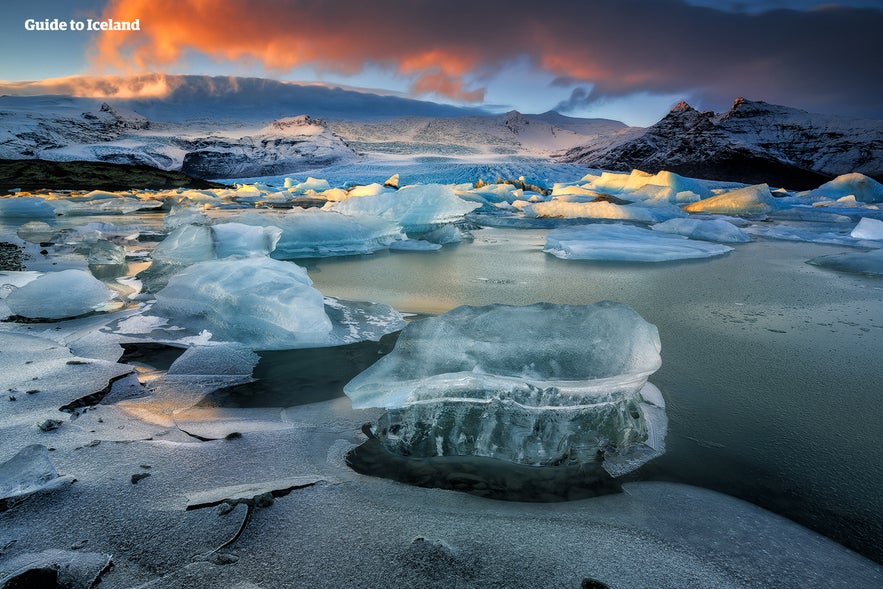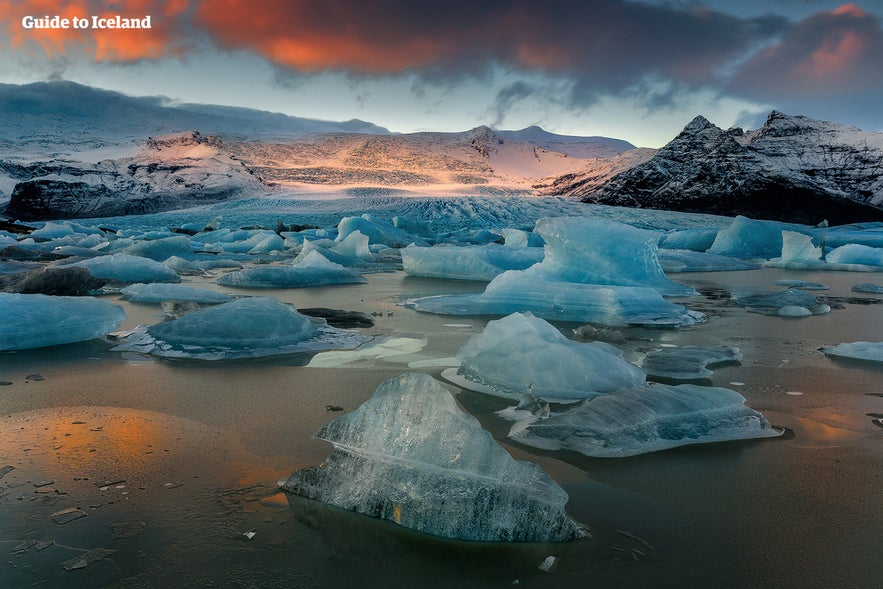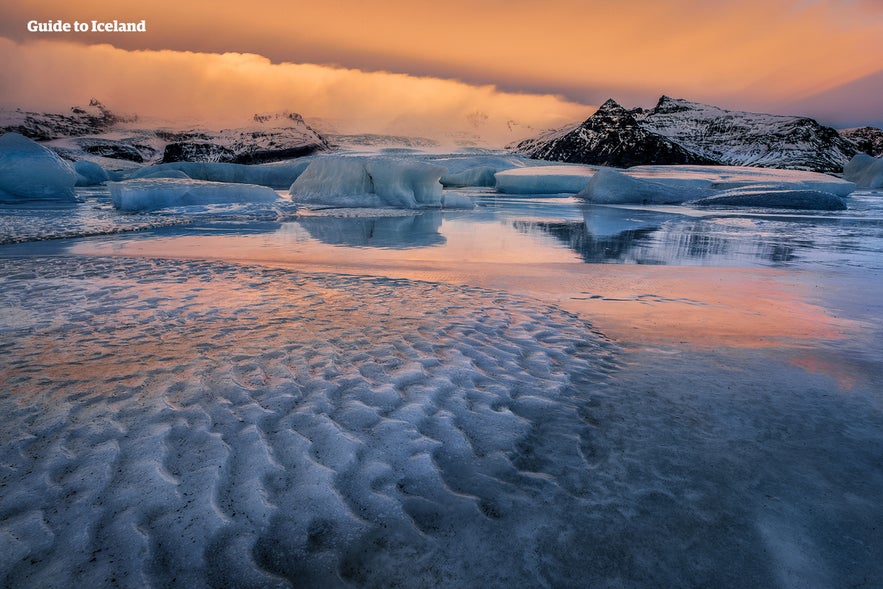Fjallsjokull, spelled Fjallsjökull in Icelandic, is an outlet glacier part of Oraefajokull, an ice-covered volcano in southeast Iceland. Next to Fjallsjokull is the Fjallsarlon, a small but stunning glacier lagoon filled with icebergs. It’s one of Iceland’s numerous natural attractions with stunning views and rugged beauty.
The Fjallsarlon glacier lagoon is a favorite destination among locals and tourists. It also sits close to the Jokulsarlon glacier lagoon, considered Fjallsarlon’s big brother. You can visit the Fjallsarlon glacier lagoon by joining this immersive private boat tour.
Derfor kan du stole på vores indhold
Guide to Iceland er den mest pålidelige rejseplatform i Island, der hjælper millioner af besøgende hvert år. Alt vores indhold er skrevet og gennemgået af lokale eksperter, der kender Island ud og ind. Du kan stole på, at vi giver dig præcise, opdaterede og pålidelige rejsetips.
Fjallsjokull is only one of the smaller glaciers found in the ice cap of Vatnajokull, Iceland’s largest glacier. Going to the Fjallsarlon Lagoon will give you breathtaking views of the Fjallsjokull outlet glacier and more.
The Wonders of Fjallsjokull Glacier and the Fjallsarlon Glacier Lagoon
When you visit Fjallsjokull, look at the key elements that make this glacier one of the fascinating natural formations in Iceland. One of the first things to appreciate is the ice cap, which makes part of the larger Vatnajokull ice cap.
 The Vatnajokull ice cap has a coverage area of around 2,972 square miles (7,700 square kilometers). It also has a thickness of 1,312 feet (400 meters) and could increase to 3,280 feet (1,000 meters) during winter.
The Vatnajokull ice cap has a coverage area of around 2,972 square miles (7,700 square kilometers). It also has a thickness of 1,312 feet (400 meters) and could increase to 3,280 feet (1,000 meters) during winter.
Interestingly, the Vatnajokull ice cap covers over 8% of the country. It’s also home to rivers and waterfalls.
Meanwhile, Fjallsjokull’s glacier tongue measures about 3.1 miles (five kilometers) long. The tongue starts from the main ice cap, eventually leading to the Fjallsarlon lagoon.
Approaching the lagoon is like entering a different world with things you’ll never imagine seeing. As you step closer to Fjallsarlon and look up, you’ll notice the Oraefajokull glacier looming from above, its icebergs reaching the lake and breaking down before quietly drifting until they melt.
Aside from the lagoon, Fjallsjokull also boasts several stunning ice caves. These ice caves go through a cycle of melting and re-freezing in the glacier every year.
As various colors and shapes await, prepare to be mesmerized once you enter the caves. You may see ice caves that look like frozen ocean waves. Other caves may give you an eerie vibe, with the dark clouds peeking outside.
However, you can only enter these ice caves during winter and only with a guide. Any other season can be dangerous, as the ice may not be stable enough for you to pass under.
Location of Fjallsarlon Glacier Lagoon
 Since the Fjallsarlon glacier lagoon is part of Fjallsjokull, it’s also found inside the Vatnajokull National Park, one of Iceland’s three national parks. Coming from Reykjavik, The Fjallsarlon glacier lagoon is just off the highway. There’s a dirt road that leads to the lagoon’s isolated location.
Since the Fjallsarlon glacier lagoon is part of Fjallsjokull, it’s also found inside the Vatnajokull National Park, one of Iceland’s three national parks. Coming from Reykjavik, The Fjallsarlon glacier lagoon is just off the highway. There’s a dirt road that leads to the lagoon’s isolated location.
The area is also known for its rivers and volcanic and geothermal activity that cause mountains, glaciers, and other landscapes to form throughout the centuries.
What Makes Fjallsarlon Special?
What makes a trip to Fjallsjokull a must in your Iceland itinerary? First is Fjallsjokull’s interesting manner of formation. Unlike major glaciers in the region, Fjallsjokull is an outlet glacier of a bigger one.
Its small size helped create a unique character for Fjallsjokull. It features its own set of incredible ice formations and dramatic landscapes. Compared to other glaciers, Fjallsjokull is relatively accessible.
The Fjallsarlon Lagoon’s unique location makes it one of Iceland’s hidden gems. You also need to join a boat tour to Fjallsarlon to experience the beauty and majesty of the lagoon up close.
People can easily explore the area since it’s already located within Vatnajokull National Park. Furthermore, climbers and hikers find Fjallsjokull an attractive spot for outdoor adventure.
Sad as it may seem, Fjallsjokull is also a reminder to take climate change seriously. Fjallsjokull is also feeling the effects of rising temperatures in recent years.
How to the Fjallsarlon Glacier Lagoon
 There are three ways to get to Fjallsjokull: Joining a tour, renting a car, or riding public transportation.
There are three ways to get to Fjallsjokull: Joining a tour, renting a car, or riding public transportation.
The most convenient and productive way is to join a Fjallsjokull tour. Not only can you relax in the vehicle while appreciating the views, but an experienced guide will also talk about the history of Fjallsjokull and the other attractions and activities in the park, like a canyoning adventure tour.
If you wish to take the self-drive route, you’ll take Road 1 out of the city. It’s a reasonably easy drive since you only need to keep driving toward the east until you finally reach Vatnajokull National Park. The great thing about going to Fjallsjokull is the awe-inspiring scenery you’ll see along the way.
Lastly, you can take the public bus. You’ll want to take the 72 bus to Fludir before alighting at Selfoss.
Take the 51 bus from there toward Vik i Myrdal, a remote seafront village in south Iceland. Lastly, take the 51 bus from Vik i Myrdal heading to Hofn i Hornafirdi, then alight at
Nearby Attractions to Visit
When visiting Fjallsjokull, consider dropping by the different attractions near the area. Aside from Fjallsarlon, Jokulsarlon is another glacier lagoon worth visiting. Located about 8.7 miles (14 kilometers) from Fjallsjokull, Jokulsarlon features blue water with dotted icebergs from the Breidamerkurjokull glacier.
Since the icebergs are Jokulsarlon’s main attraction, you find a boat tour to bring you closer to them.
You can also visit the Hofskirkja church, about 62 miles (100 kilometers) from Vatnajokull National Park. Hofskirkja is one of Iceland’s rare turf churches known for its distinctive features.
The church’s main structure features wooden timber with walls made of rock. Its roof is covered in turf while the structure is partially submerged partially in the ground, creating a cooling effect during summer.
As for the interior, the church is divided into three sections: a nave for the congregation, a chancel for the musical instruments, and an altar.
If you have time, you can drive to Skaftafell National Park, about 50 miles (80 kilometers) from Fjallsjokull. It is the country’s second-largest national park and has a landscape similar to some of those you’ll find in the Alps. In 2008, Skaftafell officially became part of Vatnajokull National Park.
Inside the park is the Svartifoss waterfall. Measuring only 66 feet (20 meters) tall, Svartifoss isn’t known for its power. However, its beautiful formation, complemented by its impressive surroundings, makes it one of the most favorite stops in the area.









